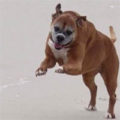Aging and its consequences
Aging and its consequences
While it is true that aging is irreversible, and that there are many theories about how it occurs, certain effects of aging at the cellular, organic, behavioral and sensory levels appear to be less well defined. The best possible knowledge of these effects will allow the owner to improve the dog’s overall health environment, of which food adapted to the dog is an essential part, helping to reduce factors that exacerbate the normal aging processes. “Old age” begis at different times in different breeds. Small-breed dogs are old at about eight years of age, medium-breed dogs at seven years of age, and large-breed dogs at the age of six. The changes that appear with age gradually increase the dog’s susceptibility to disease and stress. In old dogs, the risk of mortality is considered to double every one or two years. Physiological potential decreases with age, and the animal becomes more vulnerable to stress of all types, at the same time its immune protection from infectious diseases is decreasing.
In terms of the overall body composition, the following are seen in old dogs:
– an increase in fat deposits, as the dog is fatter and cannot mobilize lipids as well, and
– reduced hydration, or chronic dehydration, which is harmful to proper functioning of the body.
Some non-digestive functions are altered:
– reduction of immunity,
– reduced resistance to cold and heat,
– gradual reduction of kidney function,
– slow demineralization of the skeleton,
– destruction of cell membranes due to oxidative membrane stress,
– increase in cases of liver or heart failure,
– obvious increase in the frequency of both benign and malignant tumors,
– the hair turns gray and the skin becomes slack.
Digestive functions are also affected:
– Once old age has set in, the teeth may suddenly become a problem, with increased tartar formation (which should be treated) causing gum inflammations and infections leading to tooth loss.
– Less saliva is produced as soon as the dog becomes fat and adipose tissue invades the salivary glands.
– The passage of food through the intestinal tract slows, due to a decrease in intestinal muscle tone. This subjects the dog to bouts of constipation, often followed by diarrhea.
– The intestine becomes increasingly less able to adapt to changes in diet. For this reason, the diet must remain the same. Absorption of the food is also less efficient, requiring that the dog be fed a highly digestible food.
Finally, the dog’s senses and behavior also change:
– Loss of visual acuity and hearing are common.
– The sense of smell may diminish.
– Being weaker and less hardy, the dog becomes apathetic , which means that it requires a food with a lower energy content.
Nutrition of the Old Dog
Diseases of Old Age




